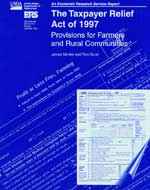The Taxpayer Relief Act of 1997: Provisions for Farmers and Rural Communities
by James Monke and
Ron DurstAgricultural Economic Report No. (AER-764) 31 pp, July 1998
 Under the Taxpayer Relief Act of 1997, most farmers will pay less Federal income tax, and farm families will find it easier to transfer the family farm across generations. The new law--the tax portion of 1997 legislation to balance the Federal budget by 2002--emerges from years of debate on proposals for tax simplification, broad tax reduction, and targeted relief for capital gains and estate taxes. The legislation is expected to generate a net tax reduction of $95 billion over 5 years for all taxpayers. A number of general and targeted tax relief provisions will reduce Federal taxes significantly for farmers and other rural residents, but also will increase the complexity of both Federal income and estate taxes. Farmers are expected to save more than $1.6 billion per year in Federal income taxes and $150-200 million in Federal estate taxes.
Under the Taxpayer Relief Act of 1997, most farmers will pay less Federal income tax, and farm families will find it easier to transfer the family farm across generations. The new law--the tax portion of 1997 legislation to balance the Federal budget by 2002--emerges from years of debate on proposals for tax simplification, broad tax reduction, and targeted relief for capital gains and estate taxes. The legislation is expected to generate a net tax reduction of $95 billion over 5 years for all taxpayers. A number of general and targeted tax relief provisions will reduce Federal taxes significantly for farmers and other rural residents, but also will increase the complexity of both Federal income and estate taxes. Farmers are expected to save more than $1.6 billion per year in Federal income taxes and $150-200 million in Federal estate taxes.
Keywords: farm taxation, Federal income taxes, family farm, capital gains, estate taxes, tax reform, tax policy, agricultural assets, farm income variability
In this publication...
Need help with PDFs?
Order this Publication